|
Ask most people who've actually heard of Studio Ghibli to name one of their films and there's a very good chance they'll come back with Castle in the Sky, My Neighbour Totoro, Princess Mononoke, Spirited Away or Howl's Moving Castle, all of which were directed by studio co-founder Miyazaki Hayao, whose films have won the studio a legion of fans worldwide and slew of international awards, including an Oscar for Best Animated Feature in 2003.
Less widely seen in the West is the work of studio co-founder Takahata Isao, whose films do not have the same level of international family appeal of his long-time colleague but which are, in their way, every bit as wonderful. This goes double for his astonishing first film for the studio, Grave of the Fireflies [Hotaru no Haka], an emotional stunner that prompted animation historian Ernest Rister to call it "the most profoundly human animated film I've ever seen." Takahata followed this with Only Yesterday [Omohide Poro Poro], a beautifully observed story of a 27-year-old woman who returns to the countryside village of her youth, and the ecologically conscious Pom Poko, the tale of a group of raccoons fighting human environmental incursion. Then in 1999 he made My Neighbours, the Yamadas [Hôhokekyo Tonari no Yamada-kun], a film so far removed from the tragedy and realism of Grave of the Fireflies that you'd be forgiven for thinking it was the work of a different director.
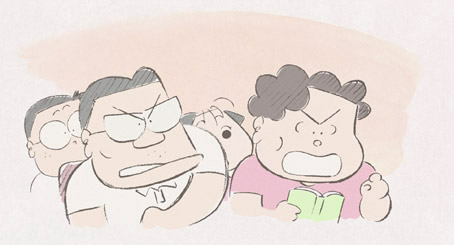
My Neighbours, the Yamadas was adapted by Takahata himself from the 4-panel comic strip by Ishii Hisaichi that originally appeared in the Asahi Shimbun (the Japanese Morning Sun newspaper), one that even in its later manga incarnation has not been read widely outside of Japan. The Yamada family in question consist of hard working salaryman Takashi, forgetful housewife Matsuko, junior high school student Noboru, his younger sister Nonoko, plain talking grandmother Shige, and their permanently grumpy pet dog Pochi. The film takes its cue from the cartoon strip, having no central narrative and consisting instead of a series of wryly amusing observations about family life, organised into titled chapters that are summarised by Haiku poems from the likes of Bashō, Santōka or Buson.
The first thing that hits you is how radically the visual style differs from the Ghibli norm. There's a seductive minimalism to the artwork that directly reflects its cartoon strip origins and is almost the complete antithesis of the densely detailed imagery of his long-time colleague Miyazaki's work. The NTV documentary on this very disc fills in some gaps here, with Takahata expressing a preference for the energy of the first draft sketches to the polish of completed drawings and employing a look based on the wash of watercolours rather than the usual hard lines and bold colours of traditional cel animation (although hand-drawn, this was also the first Ghibli film to be created completely on digital technology). The white of the background becomes the dominant colour, while objects and even locations are created using the minimum of required detail, like preliminary sketches for artwork to come, and if it's not relevant to the action then it's simply not drawn. It's a risky move that really pays off, working divinely with the short sketch structure and accurately capturing the tone of the original cartoons. In the NTV documentary, Takahata acknowledges the influence of German-born animator Frédéric Back's superb Oscar-winning 1981 animated short Crac, though provides no explanation for the brief but striking switch of style when the family confront a troublesome motorcycle gang.
There are, it has to be said, a number of Japan-specific elements that will likely fly under the radar of most western viewers. This is particularly true of the early sequence in which the history of Takashi and Matsuko's marriage is portrayed as a fable and narrated in the manner of a philosophical Olympic sports commentary – the birth of both children is drawn from ancient folk tales Taketori Monogatari (The Tale of the Bamboo Cutter) and Momotarô, and the rough seas they ride are momentarily transformed into Hokusai's iconic wood block print Great Wave off Kanagawa. The commentary, meanwhile, is provided by octogenarian actress Chōchō Miyako, whom The Japan Times described as the country's "first superstar female comedian" and who teamed with her husband Suzuo to become the country's first fufu manzai (married couple standup).
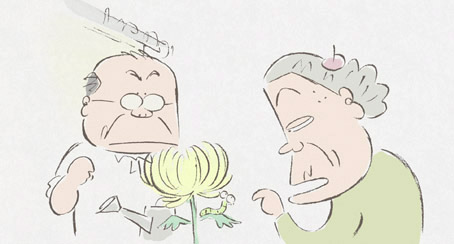
Occasionally more significant detail is lost in translation, as in the episode whose title is slightly mistranslated as A Ginger Morning (it's actually Ginger Shoot), which consists of a series of memory lapses as the family attempt set out for the day, a sketch born from the theory, still popular in Japan, that eating too much myoga ginger makes you forgetful. Perhaps more bemusing to a western audience is Takashi's dream of rescuing his family as a bike-riding superhero, a character the subtitles identify simply as "masked raider," but who is actually Gekko Kamen ("Moonlight Mask"), a popular Japanese TV superhero from the late 1950s whose jaunty theme tune plays throughout the adventure.
None of which should hamper appreciation of the film's dry humour and wry observations of the trails of family life, many of which really are universal in nature. It's doubtless this that has prompted some to label the Yamadas as the Japanese Simpsons, to which they bear only a structural resemblance (both families consist of a father, a mother, a son, a younger daughter, a single cranky grandparent and a pet dog). There is no story as such, just a series of brief but delightfully observed vignettes, few of which boast anything in the way of a punchline but which revel in Takahata's expressed desire to capture the comedy of ordinary moments. To describe any in detail would risk spoiling their effect for first-timers – it's nigh-on impossible to summarise a one or two minute sketch without giving too much away – but personal favourites include a day out that sees Nonoko accidentally left in a superstore, the family's fascination with Noboru's love life, Takashi's forlorn attempt to take a family photo in the year's first snowfall, Noboru's (supposedly) first taste of sake, Masuko and Takashi's hilarious battle for a TV remote control, the ulterior motive that prompts a girl to give Noboru her umbrella, Takashi's lightning speed distribution of new year cards, and just about anything involving the grandmother Shige. One of my very favourite sketches, for reasons I can't nail down, consists simply of Takashi arriving home from work in a state of extreme tiredness and dazedly chomping his way through a banana.
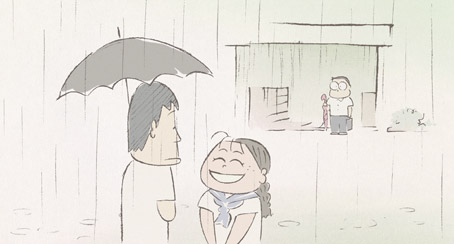
But then outlines are ultimately pointless – it's all in the execution, and that's what makes My Neighbours, the Yamadas a true Ghibli film, in spite of its stark deviance from the studio norm. Much of this is down to some spot-on casting and voice acting – Masuko Tôru as Takashi, Araki Masako as Shige and Isobata Hayato as Noboru deserve special mention here – their dry delivery and sometimes clipped Japanese giving the original voice track a serious edge over its American English counterpart, which wasn't directed by Takahata, of course. And it's Takahata who deserves the lion's share of the praise, for his work with the cast (see the NTV documentary for a peek into his perfectionism on this score), for the fleshing out of ideas from the original strip cartoon, for the film's boldly unique visual style, for it's sometimes immaculate timing (some of the funniest moments result from holding motionless on a character in frozen reaction) and for finding gentle but winning humour in the everyday world. If you spot the Ghibli logo and come looking for a fantasy in the Miyazaki mould then you're barking up the wrong film. It thus won't work for everyone, but personally, I loved it.
I should note before I start that this is a dual format release that includes both Blu-ray and DVD versions of the film, but we're working from the Blu-ray disc only so I can't comment on the quality of the DVD transfer.
Given the film's minimalist approach, an HD release may seem a little redundant, but sit this new version alongside Optimum's previous DVD and the differences are immediately evident. The higher definition and bit rate result in a picture that really sparkles (honestly, you need to see this on a full sized screen, not judge from the scaled-down and motionless frame grabs here), with smooth colour reproduction and no hint of compression artefacts on the single colour washes and gentle graduations of the backgrounds, while the crispness of the detail in pencil-line edges allows you to really appreciate Takahata's rough-edged aesthetic. The watercolour palette does mean that the picture can feel a little bright, but this is very much part of the intended look and is common to all home video versions I've seen. Being an HD transfer, this version also has none of the previous DVD's NTSC to PAL conversion issues.
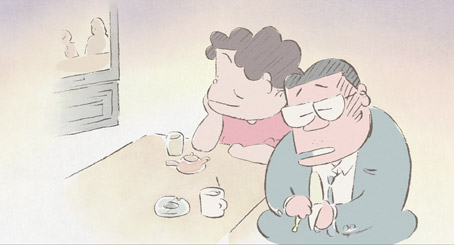
The DTS-HD Master Audio 5.1 surround track has a lovely clarity that really shines in the voices and background effects, with rainfall and fireworks being my personal favourites. The English dub, which features the voices of James Belushi, Molly Shannon and Tress MacNeille, amongst others, has been performed, recorded and mixed with care, but for me the switch to an American drawl loses the rhythm and humour of the Japanese delivery, and moves an original work into the realms of the (too) familiar, something particularly true of the rather whiny children.
Storyboards
One for the real devotees, this extra consists of slides of all of the storyboards from the planning stage of the film, with two 5-frame storyboard sheets per page and three hundred and forty-four slides in all. They are actually fascinating to flick through, not least because some of the drawings here are remarkably close to the minimalist style of the finished artwork, but there's no way to hop forward a hundred frames or so.
'Secrets of My Neighbours, the Yamadas' documentary (45:00)
A special program made for NTV covering the film's 15 month production schedule whose makers probably had enough material to fill three times this length, but it's still a most welcome and informative peek behind the scenes. The development of the visual style is covered in small hops, with Takahata encouraging his team to roughen up the drawings after the artwork starts to become too polished for his liking. Some time is spent in the recording studio, particularly on the contribution of Chôchô Miyako, who is treated like royalty and openly criticises Takahata's incorrect use of the Osaka dialect, while composer Yano Akiko reveals that the film's theme song came to her on the bus ride home after her first day at the studio (the fact that she travels to the studio by bus tells you something about Ghibli's continuing status as a cottage industry). What did surprise me – though it's genuinely hard to tell if this is a wind-up or not – is the friction that seems to exist between Takahata and Miyazaki, with Takahata expressing dissatisfaction with Mononoke hime [Princess Mononoke] and his partner's fondness for fantasy-led stories.
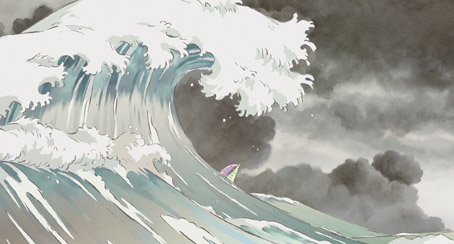
Behind the Microphone (5:30)
A promo featurette featuring the key cast members of the American dub, who are all enthusiastic for the project.
TV Spots (2:03)
Four Japanese TV spots of varying length and style in which the Yamadas are referred to twice as a "super lazy family," something I would never have described them as.
Original Japanese Theatrical Trailers (13:13)
Five Japanese trailers whose style varies even more than the TV spots and includes some draft versions of the animation, plus the unexpected proclamation that "the production has been steadily delayed" and that "we should be able to finish the movie by the opening date," not something you'll find on many Hollywood trailers.
Less widely seen in the west than Miyazaki's celebrated output for the studio, Takahata's films are every bit as beguiling and considerably more varied in their content and style. My Neighbours, the Yamadas is an unassuming delight that initially made me pine for a second or third collection of their everyday misadventures. Or maybe not. Part of the film's considerable charm is that it remains a unique one-off untainted by inferior sequels or TV spin-offs, one that shines in its humour and its entrancing style. It looks and sounds better than ever on Optimum's new Blu-ray, which together with the new documentary make it a worthwhile upgrade for those who already own the DVD. Warmly recommended.
As is our way, the Japanese convention of surname first has been used for all Japanese names.
If you want to know more about the Japanese cultural references quoted above, I've included some links to appropriate web pages below (mostly Wikipedia):
|